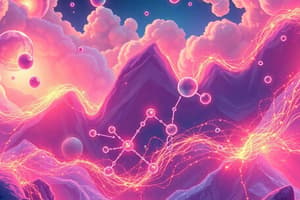Podcast
Questions and Answers
What must occur for a chemical reaction to take place according to collision theory?
What must occur for a chemical reaction to take place according to collision theory?
- Reactants must be in gaseous form.
- Reactants must collide with enough energy and in the correct orientation. (correct)
- Reactants must be in liquid form.
- Reactants must be at high temperatures.
Which of the following factors does NOT affect the rate of a chemical reaction?
Which of the following factors does NOT affect the rate of a chemical reaction?
- Frequency of collisions.
- Fraction of effective collisions.
- Color of the reactants. (correct)
- Kinetic energy of the colliding entities.
What is activation energy primarily used for in a chemical reaction?
What is activation energy primarily used for in a chemical reaction?
- To increase the temperature of the reactants.
- To overcome electrostatic forces and weaken reactant bonds. (correct)
- To speed up the reactions through catalysts.
- To change the physical state of the reactants.
What happens if reactant molecules do not have enough kinetic energy during a collision?
What happens if reactant molecules do not have enough kinetic energy during a collision?
How is the rate of a reaction mathematically expressed according to collision theory?
How is the rate of a reaction mathematically expressed according to collision theory?
In the decomposition of nitrosyl bromide, which orientation allows for an effective collision?
In the decomposition of nitrosyl bromide, which orientation allows for an effective collision?
What is represented by the Ea in the context of chemical reactions?
What is represented by the Ea in the context of chemical reactions?
Which bond requires a significant amount of energy to break during the reaction of nitrosyl bromide?
Which bond requires a significant amount of energy to break during the reaction of nitrosyl bromide?
What represents the kinetic energy of reactants in a reaction?
What represents the kinetic energy of reactants in a reaction?
How does an increase in temperature generally affect reaction rates?
How does an increase in temperature generally affect reaction rates?
Which statement about the nature of reactants is true regarding reaction rates?
Which statement about the nature of reactants is true regarding reaction rates?
What effect does increasing the concentration of reactants have on the reaction rate?
What effect does increasing the concentration of reactants have on the reaction rate?
How does the addition of a catalyst influence a chemical reaction?
How does the addition of a catalyst influence a chemical reaction?
What is the relationship between temperature and the energy of molecules in a reaction system?
What is the relationship between temperature and the energy of molecules in a reaction system?
Which of the following is a correct consequence of increased surface area in reactions?
Which of the following is a correct consequence of increased surface area in reactions?
What happens when the temperature of a reaction system is raised?
What happens when the temperature of a reaction system is raised?
Flashcards
Collision Theory
Collision Theory
Chemical reactions require reactant collisions with specific orientation and enough kinetic energy to break bonds and form new ones.
Effective Collision
Effective Collision
A collision with the correct orientation and enough energy to break bonds and form products
Activation Energy (Ea)
Activation Energy (Ea)
The minimum kinetic energy needed for a collision to be effective and break bonds in reactants.
Reaction Rate
Reaction Rate
Signup and view all the flashcards
Collision Orientation
Collision Orientation
Signup and view all the flashcards
Kinetic Energy
Kinetic Energy
Signup and view all the flashcards
Potential Energy
Potential Energy
Signup and view all the flashcards
Decomposition Reaction
Decomposition Reaction
Signup and view all the flashcards
Exothermic Reaction
Exothermic Reaction
Signup and view all the flashcards
Endothermic Reaction
Endothermic Reaction
Signup and view all the flashcards
Temperature effect on Reaction Rate
Temperature effect on Reaction Rate
Signup and view all the flashcards
Concentration effect on Reaction Rate
Concentration effect on Reaction Rate
Signup and view all the flashcards
Surface Area effect on Reaction Rate
Surface Area effect on Reaction Rate
Signup and view all the flashcards
Catalyst effect on Reaction Rate
Catalyst effect on Reaction Rate
Signup and view all the flashcards
Study Notes
Reaction Rates and Collision Theory
- Chemical reactions occur when reactant atoms, molecules, or ions collide.
- Two conditions must be met for a collision to result in a reaction:
- The colliding particles must have the correct orientation.
- The colliding particles must have sufficient kinetic energy to break existing bonds and form new ones.
- Reaction rate = frequency of collisions × fraction of effective collisions
Activation Energy
- For a reaction to proceed, reactants must possess enough kinetic energy to overcome repulsive electrostatic forces between particles and weaken bonding in the reactants.
- Activation energy (Ea): The minimum kinetic energy needed for a reaction to occur.
- Activation energy is used to overcome the repulsive forces between particles and weaken bonds in reactants.
- Activation energy is represented in an energy profile diagram as the energy difference between reactants and the transition state/activated complex.
Potential Energy in Chemical Reactions
- Potential energy is stored in the bonds within and between chemical species.
- Kinetic energy is the energy of movement of the reacting entities.
Activated Complex
- An unstable arrangement of atoms formed during a chemical reaction.
- It's a temporary, high-energy state between reactants and products.
- It is characterized by partially formed and broken bonds.
- The activated complex represents the maximum potential energy point in a reaction.
- Another name for the activated complex is the transition state.
Energy Changes during Reactions
- Exothermic reaction: Reactions that release energy to the surroundings.
- ΔH = negative value.
- Endothermic reaction: Reactions that absorb energy from the surroundings.
- ΔH = positive value.
Factors Affecting Reaction Rate Using Collision Theory
- Temperature: Increasing temperature increases the average kinetic energy of the reactants. This results in more collisions with sufficient energy to overcome the activation energy barrier leading to a higher reaction rate.
- Chemical nature of the reactants: Comparing reactions involving the breaking of different bonds with different bond strengths. Fewer bonds per reactant usually leads to faster reactions. Weaker bonds break easier and lead to faster reactions.
- Concentration: Higher concentrations of reactants mean more particles in a given volume, leading to more collisions and a higher reaction rate.
- Surface area (for solids): Increasing the surface area of a solid reactant increases the reaction rate as more reactant particles are exposed and available for collisions.
- Catalyst: A catalyst provides an alternate reaction pathway with a lower activation energy. This allows more reacting particles to have enough energy for a reaction to occur. Consequently, the rate of reaction increases.
Maxwell-Boltzmann Distribution
- Illustrates the distribution of kinetic energies among molecules at a particular temperature.
- The area under the curve represents the total number of molecules.
- Only molecules with kinetic energy equal to or greater than the activation energy are involved in effective collisions, leading to reaction.
- A higher temperature results in a greater number of molecules exceeding the activation energy (and a greater reaction rate).
Further Reading
- Biocatalysts on page 373 (as noted in last page)
Studying That Suits You
Use AI to generate personalized quizzes and flashcards to suit your learning preferences.
Related Documents
Description
Explore the concepts of reaction rates and collision theory in this quiz. Understand the conditions necessary for chemical reactions and the role of activation energy in overcoming energetic barriers. Test your knowledge of these fundamental principles in chemistry.




